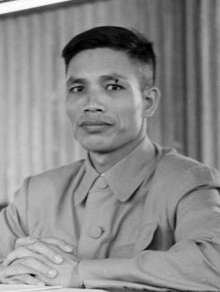Văn Tiến Dũng
| Văn Tiến Dũng | |
|---|---|
 | |
| Secretary of the Central Military–Party Committee of the Communist Party | |
|
In office 4 July 1985 – 1986 | |
| Preceded by | Lê Duẩn |
| Succeeded by | Trường Chinh |
| 6th Minister of Defence | |
|
In office February 1980 – February 1987 | |
| Preceded by | Võ Nguyên Giáp |
| Succeeded by | Lê Đức Anh |
| Member of the Politburo | |
|
In office 20 December 1976 – 18 December 1986 | |
| Personal details | |
| Born |
2 May 1917 Từ Liêm, Vietnam, French Indochina |
| Died | 17 March 2002 (aged 84) |
| Political party | Communist Party |
| Awards | Resolution for Victory Order |
| Military service | |
| Allegiance | Vietnam |
| Service/branch |
|
| Years of service | 1945–1986 |
| Rank | General |
| Commands | Vietnam People's Army |
| Battles/wars |
First Indochina War Vietnam War |
Văn Tiến Dũng (2 May 1917 – 17 March 2002), born Co Nhue commune, Từ Liêm District, Hanoi, was a Vietnamese general in the People's Army of Vietnam (PAVN), PAVN chief of staff (1954–74); PAVN commander in chief (1974–80); member of the Central Military–Party Committee (CMPC) (1984-1986) and Socialist Republic of Vietnam defense minister (1980–86).
Military career
He joined the communist Lao Dong Party in 1936, escaped from a French prison in 1944, and fought against the Japanese occupation force during the Second World War. August 1945, he directed the armed forces to seize power in the province of Hòa Bình, Ninh Bình and Thanh Hóa. By October 1953 during the First Indochina War, Dũng rose to become Chief of Staff of the Vietnam People's Army under General Võ Nguyên Giáp prior to the siege of Điện Biên Phủ in 1954. For the next twenty years, his military reputation in North Vietnam was second only to Giáp's.
He commanded the vital Tri-Thien-Hue Front during the 1972 Easter Offensive, replacing his mentor as PAVN commander in chief in 1974, when the Vietnam War against the Americans and South Vietnamese evolved from a guerrilla struggle to more conventional forms.[1][2][3]
Dũng planned and commanded the 1975 Spring Offensive, the final PAVN offensive that defeated South Vietnamese defenses and captured Saigon in 1975.[4] He also directed Vietnam's invasion of Khmer Rouge Cambodia and the resulting border conflict with the People's Republic of China in 1979.[5][6][7][8] He was appointed defense minister in 1980. He retired in December 1986 at the 6th National Congress of the Communist Party of Vietnam.
He died on the seventeenth of March 2002 in Hanoi, at the age of 84.
References
Notes
- ↑ Michael Lee Lanning and Dan Cragg, Inside the VC and the NVA: The Real Story of North Vietnam's Armed Forces (Texas A&M University Press, 2008)
- ↑ Mai Elliott, RAND in Southeast Asia: A History of the Vietnam War Era (Rand Corporation, 2010) p525
- ↑ Colonel General Trần Văn Trà (February 1983). "Vietnam: A History of the Bulwark B-2 Theater Translation of Kết thúc cuộc chiến tranh 30 năm." (PDF). United States. Joint Publications Research Service. Retrieved 14 October 2015.
- ↑ "Audio Slideshow: Black April". Los Angeles Times. Retrieved 2009-05-28.
- ↑ "China "Should Learn from its Losses" in the War against Vietnam" from "August 1" Radio, People's republic of China, 1400 GMT, February 17, 1980, as reported by BBC Summary of World Broadcasts, 22 February 1980
- ↑ Xiabing Li. A History of the Modern Chinese Army. University Press of Kentucky. Retrieved 2014-07-09.
- ↑ soha.vn/quan-su/bien-gioi-phia-bac-1979-30-ngay-khong-the-nao-quen-1-20150216095114962.htm
- ↑ Cambodia – The Fall of Democratic Kampuchea. U.S. Library of Congress. Retrieved 9 July 2013.
Sources
- Van Tien Dung, Our Great Spring Victory: An Account of the Liberation of South Vietnam. Trans. by John Spragens, Jr. New York: Monthly Review Press, 1977.
- Tobin, Thomas G., Arthur E. Laehr, and John F. Hilgenberg, Last Flight from Saigon. Maxwell Air Force Base AL: Air University Press, 1979.
- Nguyen Duy Hinh, Major General, Vietnamization and the Cease-Fire. Washington, D.C.: United States Army Center of Military History, 1980.
- Van, Canh Nguyen; Cooper, Earle (1983). Vietnam under Communism, 1975–1982. Hoover Press. ISBN 9780817978518.
- Cao Văn Viên, General, The Final Collapse. Washington, D.C.: United States Army Center of Military History, 1983.
- Military History Institute of Vietnam (2002). Victory in Vietnam: A History of the People's Army of Vietnam, 1954–1975. trans. Pribbenow, Merle. Lawrence KS: University of Kansas Press. ISBN 0700611754.
- Thayer, Carlyle (June 1987). "Vietnam's Sixth Party Congress: An Overview". Contemporary Southeast Asia. Institute of Southeast Asian Studies. 9 (1): 12–22. doi:10.1355/cs9-1b.
External links
- Interview with Van Tien Dung, 1981
- Profile of Văn Tiến Dũng
- Bibliography: Văn Tiến Dũng's writings
- CBS News report of World Airways evacuation flight from Da Nang
- Timeline of NVA invasion of South Vietnam
- “The Trials of Henry Kissinger” documentary by Eugene Jarecki (video, 1h19). Sequence on Nixon campaign sabotage of Paris Peace Accords: start 15min 20sec – end 20min 10sec.
- Tran Van Tra, Vietnam: History of the Bulwark B2 Theater, vol. 5, Concluding the 30-Year War. Ho Chi Minh City: Van Nghe Publishing, 1982. On-line edition
- The Fall of the Khmer Rouge
- 1979: Vietnam forces Khmer Rouge retreat
- Meanwhile: When the Khmer Rouge came to kill in Vietnam
- Second Life, Second Death: The Khmer Rouge After 1978
- Ministry of Defence Vietnam